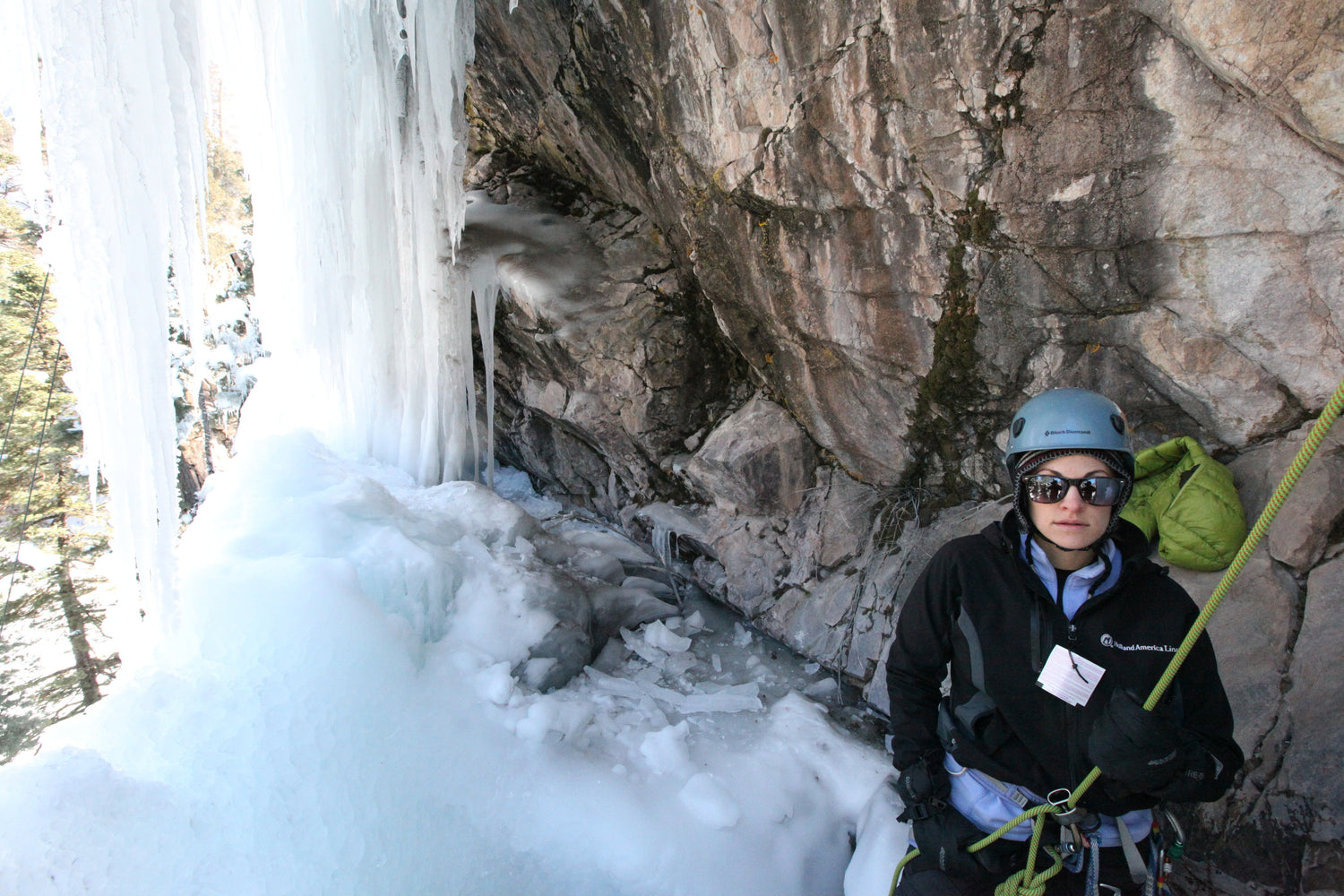Basic Winter Adventure Layering: Base to Shell
Layering your clothing correctly is an extremely important key to enjoying and surviving any adventurous winter activity.
Sweat can be a very dangerous thing. Though it is a good sign that you are warm amidst cold weather, it can later be your worst enemy. Layering too much, or attempting to contain a lot of heat during the active portion of your trip can in turn generate too much heat and cause severe sweating. Sweat, then can freeze against your body producing a dramatic swing in body temperature.That's why OVER layering can be dangerous.
On the other hand, underestimating the cold or lack of preparation, can be dangerous as well, especially in the case of a storm sneaking up on you. This is why it is important to layer appropriately and pack certain additional clothing pieces that you can quickly put on or take off accordingly.
All About Base Layers
Base Layer: Starting from the bottom, literally.
The purpose of the base layer is to allow your skin to breath and easy removal of body sweat. Moisture wicking is key.
Choose synthetic materials or merino wool blends that are water-resistant, breathable, lightweight, and close fitting. Air wicking synthetic materials and merino wools help transfer moisture away from skin to the outer layer of the fabric and evaporate quickly. (Avoid cotton!)
Note: When choosing between materials keep this in mind. Synthetic materials are prone to holding body odor and need to be washed more often, they are also not quite as warm as Merino wool. However the Merino wool blends dry fast, but not as fast as synthetic and feel a bit itchy to some people.
How to Layer Your Layers
“Bottom” Layer:
For women: Synthetic moisture wicking panties, Merino Wool blend sports bra, and/or Dri-fit tank with built in sports bra.
For Men: Synthetic moisture wicking boxer brief.
Base Layer:
For Men and Women:
TOP: Choose a synthetic moisture wicking or merino wool long sleeve shirt. This layer should fit snug to your body with a zip neck for ventilation and thumbholes to keep sleeves in place when layering.
BOTTOM: The bottoms should be synthetic moisture wicking or merino wool blend tights that fit snug to your body all the way to your ankles. Tuck your top into your tights to keep your top from rising once activity starts.
NOTE: Restrain from choosing base layers that are TOO tight, especially at wrists, waist, and ankles. If your clothing inhibits blood flow, it can interfere with transferring heat to your appendages. Cutting off the blood flow to extremities can cause severe pain and/or frostbite once the cold hits.
Choose a material level of weight or thickness depending on the severity of the cold you are entering into. This layer should be relatively thin unless severe cold environments are expected.
Mid Layer:
The purpose of the middle layer is insulation. As your base layer is transferring body heat outward the mid layer contains it inside while still allowing perspiration to vent through. Again, the thickness and type of material you choose for this layer depends on the severity of the cold and the intensity of the activity you plan to do.
For Men and Women:
TOP: A light polartec fleece is usually most appropriate for this layer. In the case of severe cold and low activity, a lightweight goose down jacket should be used for this layer.
BOTTOM: None. Mid layer top pulls down over base layer bottoms. Thick wool socks that pull up to your mid calf should be pulled over your base layer bottoms. Be sure they are snug fitting but not too tight or too loose. If they are too tight they can cut off your circulation once you slip into your boots, if they are too loose they are more likely to rub blisters quickly or fall down into your boot. All mentioned are bad situations that you do not want to interfere with your adventure.
Shell Layer:
The purpose of the shell, or outer layer, is to protect you from weather elements such as rain, wind, snow, and abrasion. This layer insulates, breaths, and protects simultaneously, allowing perspiration to evaporate while containing heat.
For Men and Women:
TOP: There are many different shells to choose from. We suggest waterproof, breathable Gore-Tex Mountaineering Jackets for optimal performance in cold, snowy/icy adventures.
BOTTOM: Insulated weatherproof snow pants. Pull your shell pants over your tights/base layer, fasten them over your mid layer top, then put your coat on top.
NOTE: Choose a shell that protects from the weather elements but still releases perspiration. If your outer shell is too sealed off, perspiration can condense inside and freeze, endangering your core temperature.
Choose a shell that fits loosely so that it will fit over all of your layers and does not restrict any body movement.
In the case that you may encounter rain, Gortex is NOT always waterproof, often it is just water resistant, if you want waterproof, be sure to check that it is before purchasing. We are offering information about attire in environments that are too cold for rain. Rainy environments are a different ballgame and would require waterproof rain jackets or coats.
ADDITIONAL LAYERS:
The purpose of these additional layers are for extra insulation when needed. They should be lightweight and kept in the top of your pack for easy access when putting them on and taking them off situationally.
For Men and Women:
TOP: Lightweight Insulating down jacket that is loose fitting and not necessarily waterproof. Quick to put on and take off when necessary.
BOTTOM: Lightweight Insulating down pants that are loose fitting and not necessarily waterproof. Quick to put on and take off when necessary
WARM CLOTHING ACCESSORIES
Face Mask: Look for a mask that has a contoured shape and wraps comfortably around your face and the back of your head. It should be made of a breathable water-resistant material with a mesh breathing port at your nose and mouth.
Hat: Lightweight synthetic/wool hat. Both the hat and the balaclava should be able to fit under a helmet if your activity requires a helmet. Hat should cover ears.
Glove Liners: Lightweight Synthetic Glove Liners. To wear alone on very sunny days for hand protection or as a layer with other gloves on colder expeditions.
Gloves: Waterproof, Gortex, insulated, five-finger gloves are usually enough for typical winter activity. For extreme cold, you can bring waterproof shell mitts w/ insulated removable liners. Make sure that you can fit your gloves inside the mitts.
Socks: Thick wool socks that pull up to your mid calf should be pulled over your base layer bottoms. Be sure they are snug fitting but not too tight or too loose. If they are too tight they can cut off your circulation once you slip into your boots, if they are too loose they are more likely to rub blisters quickly or fall down into your boot.
If you have heavy duty, high insulating, mountaineering boots, there should be no reason to layer socks. In fact, layering socks can make your boot too tight, your feet are very important and susceptible to freezing.
Scarf: Personally I do not think they are necessary if you have all of the essential layering items previously stated. The only time I think you really could make use of a scarf would be to sleep in, yet still, I find them unnecessary.
Boots: Silicone impregnated leather winter mountaineering boots that with a removable/adjustable tongue, hardware that allows you to lock down the laces, and Gore-Tex lining for long lasting warmth. This boot is excellent for colder days where you need lots of support and protection on technical long endeavors. Mountaineering boots are my choice winter wear. When choosing your boots it is a good idea to purchase boots that are 1.5 to 2 sizes too big. This way they will fit snug, but not too tight over a thick wool sock.
NOTE: If for any reason you have to take off a glove, first make sure it is connected to you in some way. Holding it in your teeth does not count! Losing a glove to the wind or off a cliff side can be a very dangerous situation.
Never tie your boots too tight or wear boots that are too small for you. Since your feet are continuously immersed in snow they need to be cared for especially well. When your boots are too tight, you risk the chance of cutting off the blood flow to your toes. This will make them get very cold very fast and risk frost bite or strong pain. Having to retie a boot in the cold is difficult with gloves on, and poses the risk of having to take your gloves off to retie.
In conclusion, the purpose for layering is to create warm insulation for your body that simultaneously releases perspiration, allows you to move freely, and can be removed or added back depending on the environment and your body temperature.
DO NOT OVER LAYER!
More often than not a person overestimates the cold and underestimates their physical activity. In return, they sweat themselves to death once they get moving. If you feel your self start to sweat, unzip your shell, unzip the neck of your mid layer, and unzip the neck of your base layer for ventilation. DO this first before losing an entire layer to see if it makes a difference. If you continue to sweat, loose the mid layer and zip your shell back up. On the other hand, if you feel too cold, add the additional down jacket you have in the top of your pack.


